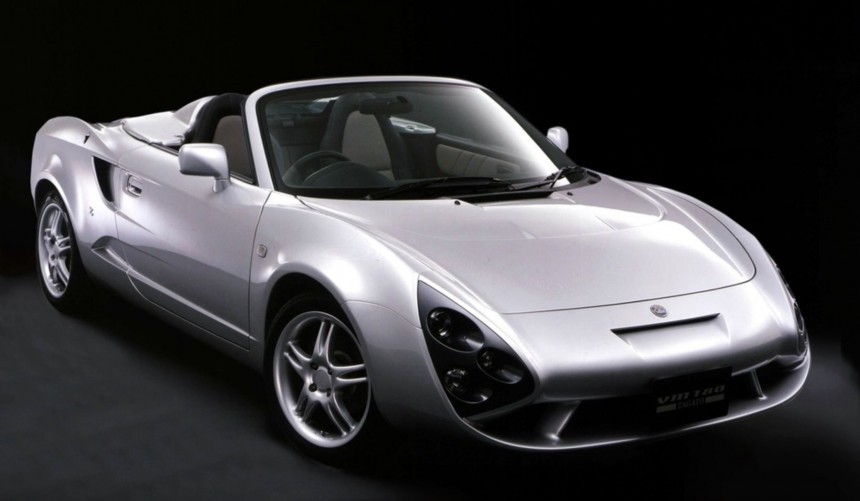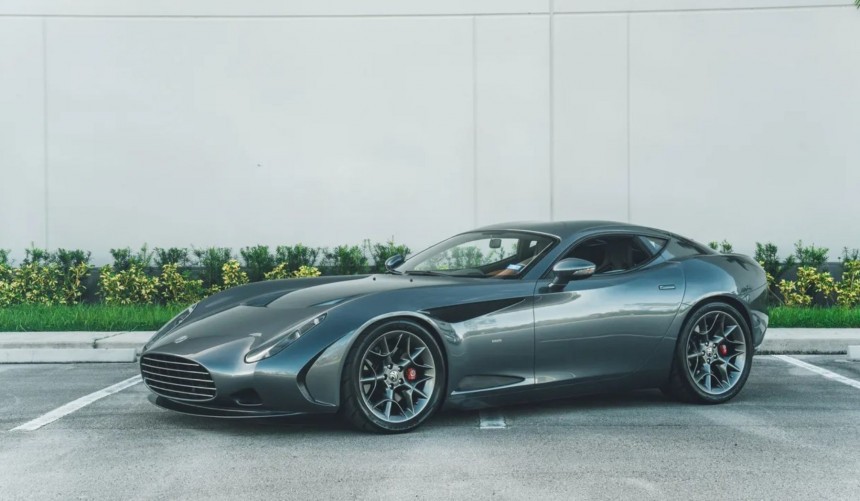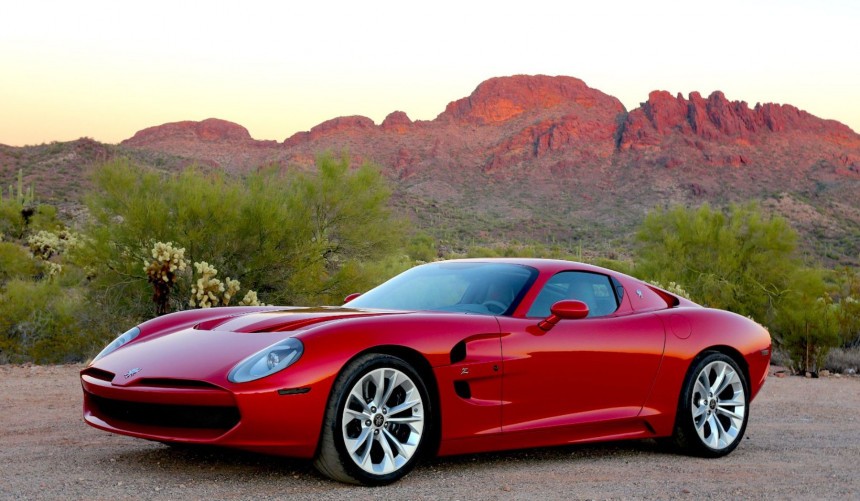One of Italy's most prestigious coachbuilders, Zagato has crafted gorgeous bodies for many iconic classics, as well as several modern models that few still remember.
Founded by famed designer Ugo Zagato in 1919, the coachbuilding company quickly made a name for itself by designing race cars and focusing on aerodynamics.
By the 1950s, Zagato was building exquisite bodies for several important carmakers, and in the decades that followed, it became one of the world's most prestigious design houses.
Many timeless classics, such as the Fiat 8V, Alfa Romeo Giulietta SZ, Lancia Fulvia Sport Zagato, and Aston Martin DB4 GT Zagato, donned bodies crafted by the legendary coachbuilder. But while those classics remain famous, more modern Zagato masterpieces have been unfairly forgotten.
Unveiled at the 1996 Geneva Auto Show, this beauty was the result of Swiss skeleton racer Alain Wicki's desire to own a fundamentally different Lamborghini Diablo.
Yes, the Raptor was based on a 4WD Diablo VT, but the body was completely redesigned by Zagato's Norihiko Harada with the aid of then-state-of-the-art CAD (computer-aided design) software.
It was powered by the stock 492 hp Lamborghini V12 mated to a five-speed manual, and to make it more thrilling for its adrenaline junkie owner, the ABS and traction control systems were removed.
Nevertheless, Zagato incorporated several reinforcements to make the unique carbon fiber body safe in the event of a crash and also added a better Brembo braking system instead of the one that came with the Diablo VT from the factory.
Zagato explored the possibility of commencing a very limited production run of the Raptor and even convinced Lamborghini to support the project.
Unfortunately, after crunching the numbers, both companies realized that the Zagato-bodied Diablo would be too much of a gamble, so the beauty never made it into production.
I'm sure most of our readers are familiar with at least one of the three MR2, Toyota's two-seat, mid-engine sports car. However, I'm just as sure that few know Zagato built a limited edition of the third-generation model.
First revealed at the Tokyo Motor Show in January 2001, the limited edition MR2 was actually dubbed TMI VM180 Zagato.
It was conceived to draw attention to the manufacturer's factory-backed custom vehicle and components division, Toyota Modellista International (TMI), and was only available for the Japanese market.
Apart from the redesigned Zagato body, the VM180 also received custom wheels, new seats, and an improved version of the 1.8-liter 1ZZ-FE inline-four that was pushed from 138 to 155 hp.
Only 100 examples were built in 2001, and since they were only sold in Japan, all were right-hand drive.
During the second half of the 1950s, Zagato was responsible for crafting bespoke bodies for several examples of the Ferrari 250 GT Berlinetta "Tour de France."
Those cars, considered some of the most beautiful Ferraris of the 1950s, inspired famed fashion designer and car collector Yoshiyuki Hayashi to commission the creation of a spiritual successor.
Zagato put together several sketches that impressed the enthusiastic collector and began work on the body using the Ferrari 575M chassis as a base.
To modify the grand tourer and fulfill Hayashi's request of using Ferrari badges, Zagato had to notify the carmaker of the project and gain permission.
Not only did Ferrari decision-makers give their blessing, but they also felt the re-bodied car was perfect for commemorating the 50th anniversary of the 250 range.
Thus, in addition to the collector's car, four other 575 GTZs were built. The cars were displayed at several official events marking the above-mentioned anniversary and sold to prestigious Ferrari clients afterward.
In the second part of the 2000s, Zagato built a beautiful concept car called Z-One, which became the basis for South Africa's most breathtaking supercar.
The effort, headed by a group of ambitious enthusiasts who revived the local Perana brand commenced during the 2007–2008 financial crisis, so, as you would expect, the initial plan to build 999 units of the Z-One never materialized.
Nevertheless, a handful of them were built and sold to wealthy customers worldwide.
By 2012, Hi-Tech Automotive, a low-volume replica builder and design house located in Port Elizabeth, who was responsible for the assembly of the Z-One, purchased the rights to the project and struck a deal with UK-based AC Cars to continue production.
Renamed AC 378 GT Zagato, the beautiful GT carried the same Italian-designed body as the Z-One.
It was based on a Corvette C6 chassis and was powered by a 6.2-liter LS3 Chevy small-block V8 rated at 437 hp - albeit, some cars received custom Chevy engines as well as supercharged LS3s
Unfortunately, this second attempt at building a successful Zagato-bodied South African supercar with American power and British badges failed. Fewer than a dozen were built, including both Z-Ones and 378 GTs.
Back in the 1950s, engineer Renzo Rivolta, the owner of Iso Autoveicoli (later Iso Rivolta), expanded his business from motorcycles to small city cars with the introduction of the famed Isetta, which was also produced in Germany, under license, by BMW.
The Isetta opened new doors for Rivolta and his company, so by the early 1970s, Iso had a lineup of intriguing grand tourers powered by Chevy and Ford engines.
Unquestionably, the most famous Iso was the 1965–1974 Grifo designed by Giorgetto Giugiaro during his Bertone years.
The Grifo also had a race-bed Le Mans class-winning sibling called A3/C, which was developed by the famous Giotto Bizzarrini and that car served as the basis for the modern Iso Rivolta GTZ.
Designed by Zagato's Norihiko Harada, who also penned the Z-One/378 GT Zagato, the GTZ is another re-bodied Corvette, but this time, the newer, more powerful C7 Z06 was chosen.
Thanks to the 650-hp LT1 hidden under its hood, the gorgeous and aerodynamically-superior Iso, produced in 19 units, could accelerate from 0 to 60 mph (97 kph) in 3.7 seconds on its way to a top speed of 196 mph (315 kph).
By the 1950s, Zagato was building exquisite bodies for several important carmakers, and in the decades that followed, it became one of the world's most prestigious design houses.
Many timeless classics, such as the Fiat 8V, Alfa Romeo Giulietta SZ, Lancia Fulvia Sport Zagato, and Aston Martin DB4 GT Zagato, donned bodies crafted by the legendary coachbuilder. But while those classics remain famous, more modern Zagato masterpieces have been unfairly forgotten.
1996 Zagato Raptor
Yes, the Raptor was based on a 4WD Diablo VT, but the body was completely redesigned by Zagato's Norihiko Harada with the aid of then-state-of-the-art CAD (computer-aided design) software.
It was powered by the stock 492 hp Lamborghini V12 mated to a five-speed manual, and to make it more thrilling for its adrenaline junkie owner, the ABS and traction control systems were removed.
Nevertheless, Zagato incorporated several reinforcements to make the unique carbon fiber body safe in the event of a crash and also added a better Brembo braking system instead of the one that came with the Diablo VT from the factory.
Zagato explored the possibility of commencing a very limited production run of the Raptor and even convinced Lamborghini to support the project.
Unfortunately, after crunching the numbers, both companies realized that the Zagato-bodied Diablo would be too much of a gamble, so the beauty never made it into production.
2001 TMI VM180 Zagato
First revealed at the Tokyo Motor Show in January 2001, the limited edition MR2 was actually dubbed TMI VM180 Zagato.
It was conceived to draw attention to the manufacturer's factory-backed custom vehicle and components division, Toyota Modellista International (TMI), and was only available for the Japanese market.
Apart from the redesigned Zagato body, the VM180 also received custom wheels, new seats, and an improved version of the 1.8-liter 1ZZ-FE inline-four that was pushed from 138 to 155 hp.
Only 100 examples were built in 2001, and since they were only sold in Japan, all were right-hand drive.
2006 Ferrari 575 GTZ
Those cars, considered some of the most beautiful Ferraris of the 1950s, inspired famed fashion designer and car collector Yoshiyuki Hayashi to commission the creation of a spiritual successor.
Zagato put together several sketches that impressed the enthusiastic collector and began work on the body using the Ferrari 575M chassis as a base.
To modify the grand tourer and fulfill Hayashi's request of using Ferrari badges, Zagato had to notify the carmaker of the project and gain permission.
Not only did Ferrari decision-makers give their blessing, but they also felt the re-bodied car was perfect for commemorating the 50th anniversary of the 250 range.
Thus, in addition to the collector's car, four other 575 GTZs were built. The cars were displayed at several official events marking the above-mentioned anniversary and sold to prestigious Ferrari clients afterward.
2009 Perana Z-One/ 2012 AC 378 GT Zagato
The effort, headed by a group of ambitious enthusiasts who revived the local Perana brand commenced during the 2007–2008 financial crisis, so, as you would expect, the initial plan to build 999 units of the Z-One never materialized.
Nevertheless, a handful of them were built and sold to wealthy customers worldwide.
By 2012, Hi-Tech Automotive, a low-volume replica builder and design house located in Port Elizabeth, who was responsible for the assembly of the Z-One, purchased the rights to the project and struck a deal with UK-based AC Cars to continue production.
Renamed AC 378 GT Zagato, the beautiful GT carried the same Italian-designed body as the Z-One.
It was based on a Corvette C6 chassis and was powered by a 6.2-liter LS3 Chevy small-block V8 rated at 437 hp - albeit, some cars received custom Chevy engines as well as supercharged LS3s
Unfortunately, this second attempt at building a successful Zagato-bodied South African supercar with American power and British badges failed. Fewer than a dozen were built, including both Z-Ones and 378 GTs.
2021 Iso Rivolta GTZ
The Isetta opened new doors for Rivolta and his company, so by the early 1970s, Iso had a lineup of intriguing grand tourers powered by Chevy and Ford engines.
Unquestionably, the most famous Iso was the 1965–1974 Grifo designed by Giorgetto Giugiaro during his Bertone years.
The Grifo also had a race-bed Le Mans class-winning sibling called A3/C, which was developed by the famous Giotto Bizzarrini and that car served as the basis for the modern Iso Rivolta GTZ.
Designed by Zagato's Norihiko Harada, who also penned the Z-One/378 GT Zagato, the GTZ is another re-bodied Corvette, but this time, the newer, more powerful C7 Z06 was chosen.
Thanks to the 650-hp LT1 hidden under its hood, the gorgeous and aerodynamically-superior Iso, produced in 19 units, could accelerate from 0 to 60 mph (97 kph) in 3.7 seconds on its way to a top speed of 196 mph (315 kph).






















